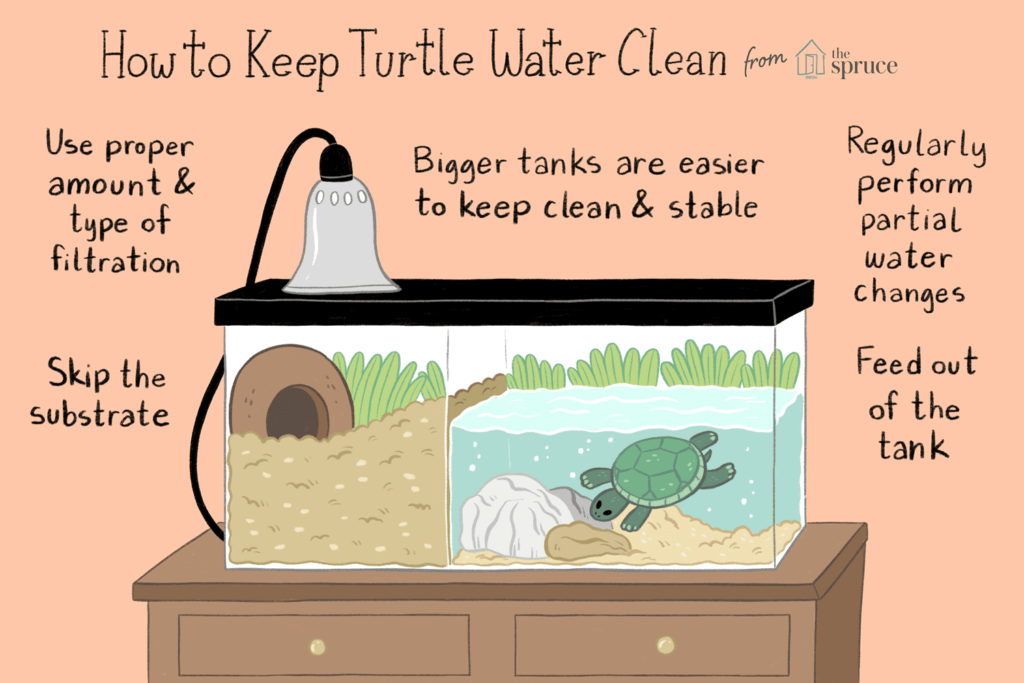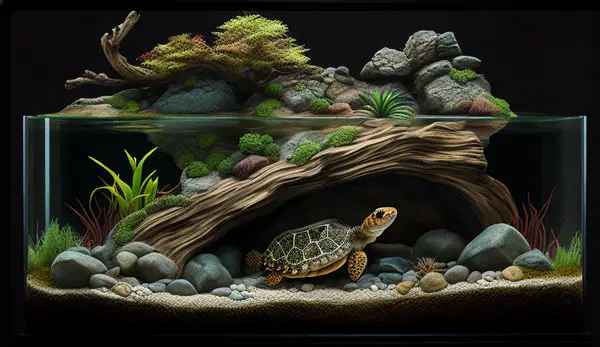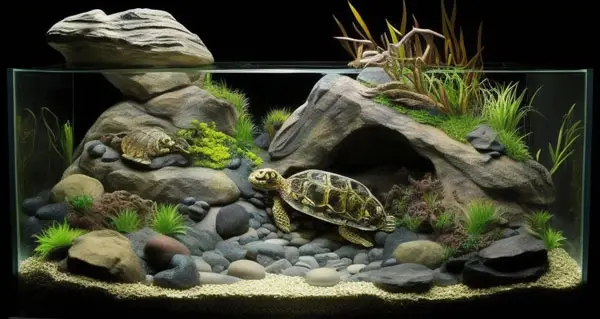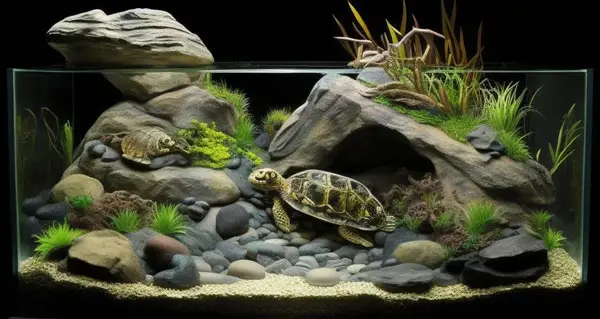In maintaining clean and healthy turtle habitats, regular water changes play a crucial role. By regularly changing the water in your turtle’s habitat, you can effectively remove any accumulated waste, toxins, and other harmful substances that may threaten the well-being of your pet. Not only does this promote a cleaner environment for your turtle, but it also helps to prevent the growth of harmful bacteria and algae, ensuring your turtle enjoys a thriving and hygienic habitat. Ultimately, by understanding the importance of regular water changes, you can provide a safe and comfortable home for your beloved turtle.

Introduction
Keeping a turtle as a pet can be a rewarding and fulfilling experience. These fascinating creatures bring joy and tranquility to our lives. However, ensuring the well-being of our turtle companions requires more than just providing them with food and shelter. One crucial aspect of turtle care is maintaining clean and healthy habitats. Regular water changes play a vital role in achieving this goal. By understanding the importance of clean and healthy turtle habitats, we can ensure the longevity and happiness of our beloved turtles.
1. Understanding the Importance of Clean and Healthy Turtle Habitats
1.1 Ensuring the Well-being of the Turtles
Clean and healthy turtle habitats are essential for maintaining the overall well-being of turtles. Just like any other living creature, turtles thrive in environments that support their physiological needs. Dirty or contaminated water can lead to stress and illness in turtles. By providing them with a clean and healthy habitat, we can help them lead a comfortable and happy life.
1.2 Preventing Diseases and Infections
One of the primary reasons for regular water changes is the prevention of diseases and infections in turtles. Accumulation of waste and the growth of harmful bacteria in stagnant water can lead to various health issues for turtles. By removing the old water and replacing it with clean water, we can significantly reduce the risk of diseases and infections, thereby ensuring the longevity of our turtles.
1.3 Creating a Balanced Aquatic Environment
Maintaining clean and healthy turtle habitats also involves creating a balanced aquatic environment. Turtles require specific water conditions to thrive, including appropriate temperature, pH levels, and proper filtration. Regular water changes help maintain these parameters, ensuring that the habitat remains conducive to the turtles’ well-being. Creating a balanced aquatic environment not only promotes the health of the turtles but also enhances the overall aesthetics of the habitat.
2. What Does a Water Change Entail?
2.1 Complete Water Replacement vs. Partial Water Changes
When it comes to water changes, there are two methods to consider: complete water replacement and partial water changes. Complete water replacement involves removing all the water from the tank and replacing it with fresh water. On the other hand, partial water changes involve removing a portion of the old water and adding an equal amount of fresh water.
The choice between complete water replacement and partial water changes depends on various factors, including the size of the tank, the number of turtles, and the water quality. Complete water replacement is more time-consuming and may disrupt the tank’s ecosystem, particularly if there are beneficial bacteria present. Partial water changes are generally recommended as they help maintain a stable environment while keeping waste levels in check.
2.2 Frequency of Water Changes
Determining the frequency of water changes is crucial for maintaining clean and healthy turtle habitats. The frequency depends on several factors, including the tank size, the number of turtles, and the filtration system. As a general guideline, it is recommended to perform partial water changes every two to four weeks.
However, it is essential to monitor the water quality closely. If you notice a significant accumulation of waste or a decline in water parameters, more frequent water changes may be necessary. Conversely, if the water quality remains consistently good and the turtles show no signs of stress or illness, you may opt for less frequent water changes.
2.3 Considerations for Water Source
Choosing the right water source for your turtle’s habitat is essential to maintain their health and well-being. Tap water may contain chlorine, chloramine, or heavy metals that can be harmful to turtles. It is crucial to treat the water properly to eliminate these contaminants before adding it to the habitat.
Dechlorinating agents are readily available in pet stores and effectively remove chlorine from tap water. Additionally, some filters have built-in capabilities to remove or neutralize chlorine and chloramine. Alternatively, using filtered or bottled water can also be an option. Regardless of the water source chosen, it is crucial to ensure that it is safe and free from harmful chemicals.
2.4 Temperature and pH Control
Temperature and pH are two critical factors that need to be considered during water changes. Turtles require specific temperature ranges and pH levels to thrive. It is important to ensure that the newly added water matches the temperature and pH of the existing habitat. Sudden changes in these parameters can cause stress and health issues for turtles.
To achieve the desired temperature, you may need to use a reliable thermometer and a reliable heating source, such as aquarium heaters. As for pH control, test kits are readily available to monitor and adjust the pH levels accordingly. By maintaining consistent temperature and pH during water changes, you can provide a comfortable environment for your turtles.
3. Removing Excess Waste and Contaminants
3.1 Accumulation of Ammonia and Nitrite
One of the main reasons for regular water changes is to remove excess waste, particularly ammonia and nitrite. Ammonia is a toxic substance produced from various sources, such as leftover food, decaying plants, and turtle waste. Nitrite, a byproduct of ammonia breakdown, is equally harmful to turtles.
When ammonia and nitrite levels rise in the water, they can lead to ammonia poisoning and other health problems in turtles. Performing regular water changes helps dilute these harmful substances and maintain a healthy balance in the habitat. By removing the excess waste and contaminants, we can prevent potential harm to our turtles and promote their overall well-being.
3.2 The Role of Filtration Systems
Filtration systems play a crucial role in maintaining clean and healthy turtle habitats. They help remove physical debris and filter out harmful substances, thus improving water quality. There are various types of filtration systems available, including mechanical, biological, and chemical filters.
Mechanical filters remove larger particles and debris from the water, preventing them from accumulating and causing water pollution. Biological filters promote the growth of beneficial bacteria that break down harmful substances like ammonia and convert them into less toxic forms. Chemical filters, such as activated carbon, help remove impurities and odors from the water.
3.3 Importance of Mechanical and Biological Filtration
Both mechanical and biological filtration are essential for maintaining clean and healthy turtle habitats. Mechanical filtration removes physical debris and waste, preventing them from decomposing and contaminating the water. This helps to reduce the workload on the biological filter and promotes overall water clarity.
Biological filtration, on the other hand, helps maintain the water’s nitrogen cycle. Beneficial bacteria colonize the filter media and break down toxic substances like ammonia and nitrite, converting them into less harmful forms. This process is crucial for maintaining water quality and preventing harmful substances from accumulating in the turtle habitat.

4. Maintaining Water Quality Parameters
4.1 Monitoring Ammonia and Nitrite Levels
Monitoring ammonia and nitrite levels is essential for maintaining clean and healthy turtle habitats. High levels of ammonia and nitrite can lead to stress, illness, and even death in turtles. Regular testing using test kits specifically designed for aquariums can help ensure that these levels remain within a safe range.
When performing water changes, it is important to address any abnormalities in ammonia and nitrite levels promptly. If the levels are elevated, it may indicate a problem with the filtration system or overfeeding. Adjustments should be made to reduce these levels and prevent harm to the turtles.
4.2 Managing Nitrates and Nitrate Build-up
Nitrates are a byproduct of the nitrogen cycle and are less harmful than ammonia and nitrite. However, high levels of nitrates can still be detrimental to turtles. They can cause stress and contribute to poor water quality. Regular water changes help lower nitrate levels, maintaining a healthy and balanced environment for the turtles.
In addition to water changes, other methods for managing nitrates include the use of live plants and regular substrate vacuuming. Live plants utilize nitrates as nutrients, minimizing their accumulation in the water. Vacuuming the substrate helps remove any organic matter that may contribute to nitrate build-up.
4.3 Controlling pH Levels
pH levels in the turtle habitat should be monitored regularly to ensure the turtles’ well-being. Turtles require a specific pH range to maintain good health and prevent stress-related issues. pH levels can fluctuate due to factors such as the breakdown of waste, water source, and the presence of shells or rocks in the habitat.
Maintaining stable pH levels is crucial during water changes. Sudden changes in pH can cause stress and health problems for turtles. Monitoring the pH regularly and adjusting it gradually, if necessary, helps provide a stable environment and ensures the turtles’ comfort and well-being.
4.4 Importance of Temperature Regulation
Temperature regulation is vital for maintaining clean and healthy turtle habitats. Turtles are ectothermic creatures, meaning they rely on their environment to regulate their body temperature. Maintaining a consistent temperature range in their habitat is essential for their overall well-being.
During water changes, it is important to match the temperature of the newly added water to that of the existing habitat. Sudden changes in temperature can stress turtles and compromise their immune system. Using a reliable thermometer and a heater, if necessary, helps provide a stable and comfortable environment for the turtles.
5. Optimizing Water Conditions for Turtle Health
5.1 Avoiding Stress and Respiratory Issues
Clean and healthy water conditions are essential for avoiding stress and respiratory issues in turtles. Poor water quality can lead to stress, which weakens the immune system and makes turtles more susceptible to diseases. Furthermore, stagnant and dirty water can cause respiratory problems in turtles, such as bacterial or fungal infections.
By maintaining clean and oxygenated water through regular water changes, we can significantly reduce the risk of stress and respiratory issues. This promotes the overall health and well-being of our turtles, allowing them to thrive in their habitat.
5.2 Preventing Shell and Skin Problems
Shell and skin problems are common issues in turtles, often caused by poor water conditions. A dirty habitat can lead to the growth of algae, fungi, and bacteria on the turtle’s shell and skin, resulting in shell rot and other skin infections. Regular water changes help prevent the accumulation of harmful substances and maintain optimal water conditions for healthy shell and skin.
In addition to water changes, providing proper basking areas and UVB lighting is essential for shell and skin health. Basking areas allow turtles to dry out completely, preventing constant moisture and minimizing the risk of shell and skin problems.
5.3 Promoting Healthy Growth and Development
Clean and healthy water conditions contribute to the healthy growth and development of turtles. Providing them with a suitable habitat that mimics their natural environment promotes physical and mental well-being. Regular water changes ensure that the habitat is free from contaminants and provides the necessary conditions for healthy growth.
A balanced aquatic environment also encourages natural behaviors and stimulates turtles mentally and physically. Swimming, exploring, and basking opportunities promote exercise and a robust immune system. By optimizing water conditions through regular water changes, we can contribute to the long-term health and vitality of our turtles.

6. Step-by-Step Guide to Performing Water Changes
6.1 Gather the Necessary Equipment
Before performing a water change, gather the necessary equipment. This includes a clean bucket, a siphon or gravel vacuum, water conditioner or dechlorinator, a reliable thermometer, and a heater if needed. It is important to use separate equipment solely for the turtle habitat to prevent cross-contamination.
6.2 Preparing the New Water
Fill the clean bucket with water suitable for turtles. If using tap water, treat it with a water conditioner or dechlorinator to remove harmful chemicals like chlorine and chloramine. Ensure that the temperature and pH of the new water match those of the existing habitat. This will prevent temperature and pH shock to the turtles.
6.3 Removing the Old Water
Using a siphon or gravel vacuum, start by removing a portion of the old water. The amount to be removed depends on the frequency of water changes and the tank size. Be careful not to disturb the substrate or disturb the turtles too much during this process.
6.4 Adding the Fresh Water
Slowly add the prepared fresh water to the tank. This helps minimize stress to the turtles and prevents sudden changes in water conditions. Take care not to overflow the tank or disturb any decorations or basking areas.
6.5 Dechlorinating and Aeration
Once the fresh water has been added, treat it with a water conditioner or dechlorinator if necessary. Follow the instructions on the product regarding the appropriate dosage. Use an air stone or water pump to aerate the water, ensuring sufficient oxygenation for the turtles.
6.6 Observing the Turtles’ Behavior
After completing the water change, observe the turtles’ behavior closely. They may take some time to adjust to the new water conditions. Look for any signs of stress or respiratory issues, such as lethargy, gasping for air, or abnormal swimming patterns. Adjust any parameters if necessary, and seek veterinary advice if the turtles show signs of distress.
7. Additional Tips for Maintaining a Healthy Turtle Habitat
7.1 Proper Feeding and Waste Management
Maintaining a healthy turtle habitat involves proper feeding and waste management. Feed turtles a balanced diet consisting of commercial turtle pellets, fresh vegetables, and occasional live or frozen protein sources. Avoid overfeeding, as excess food can contribute to poor water quality. Remove any uneaten food promptly to prevent it from decomposing and releasing toxins.
7.2 Regular Tank Cleaning and Maintenance
In addition to water changes, regular tank cleaning and maintenance are essential for a healthy turtle habitat. Clean the tank glass, decorations, and filter media regularly to remove any visible waste or algae. Regularly replace or clean filter cartridges according to the manufacturer’s instructions. A clean tank reduces the workload on the filtration system and maintains optimal water conditions.
7.3 Providing Adequate Space and Basking Areas
Turtles require adequate space and basking areas in their habitat. Ensure that the tank size is appropriate for the number and size of the turtles. Provide enough swimming space and basking areas where turtles can haul out of the water and dry off completely. Basking areas should be equipped with a heat source, such as a heat lamp or UVB lamp, to provide warmth and promote healthy digestion and shell health.
7.4 Minimizing Disturbances and Noise
Turtles are sensitive creatures and can be easily stressed by disturbances and excessive noise. Minimize handling and disturbances in their habitat, as excessive stress can weaken their immune system. Avoid sudden movements, loud noises, and aggressive handling. It is important to create a calm and peaceful environment for the turtles to thrive.

8. Seeking Professional Advice
8.1 Consulting with Veterinarians and Reptile Experts
To ensure the continued health and well-being of your turtles, it is essential to seek professional advice when necessary. Veterinarians with experience in reptile care can provide guidance on overall turtle health, including diet, habitat conditions, and any specific health concerns.
Reptile experts, such as herpetologists or experienced breeders, can also offer valuable insights into maintaining clean and healthy turtle habitats. They may provide advice on specific turtle species, optimal tank setups, and best practices for water maintenance.
8.2 Identifying and Treating Health Issues
Regular observation and familiarization with the turtles’ normal behavior and appearance help identify potential health issues early. If you notice any abnormalities or signs of illness in your turtles, it is crucial to seek professional assistance promptly. Veterinarians or reptile experts can diagnose and treat common health issues, such as respiratory infections, shell problems, or nutritional deficiencies.
8.3 Regular Check-ups and Assessments
Regular check-ups and assessments with veterinarians or reptile experts are important for maintaining the long-term health of your turtles. These professionals can perform comprehensive examinations, including fecal tests, blood work, and physical evaluations, to ensure that your turtles are in optimal health. Routine assessments help detect any underlying issues and allow for early intervention and treatment.
9. Conclusion
Regular water changes are of utmost importance in maintaining clean and healthy turtle habitats. By understanding the significance of these changes, we can ensure the well-being of our turtles and promote their long and healthy lives. Proper water management, waste removal, and maintaining optimal water conditions contribute to the overall health, growth, and development of turtles. By following the step-by-step guide and implementing the additional tips provided, we can create a clean and healthy environment where our turtles can thrive. Remember to seek professional advice whenever necessary and observe the turtles closely for any signs of distress or illness. With proper care and attention, we can provide our beloved turtles with the clean and healthy habitats they deserve.

